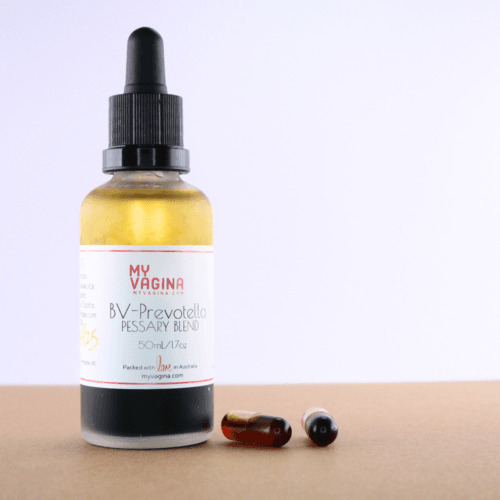Prevotella species in the vagina contribute to the microbiome through their metabolic activities, which vary based on the nutrients available, such as glucose, glycogen, or amino acids.
The byproducts of their metabolism play a significant role in altering the vaginal environment, particularly in cases of dysbiosis or bacterial vaginosis (BV).
Byproducts of glycogen/glucose metabolism by Prevotella
Prevotella species can utilise glucose, often derived from glycogen breakdown by host enzymes, through fermentation pathways.
While glucose metabolism by Prevotella produces some acidic byproducts, the overall effect is insufficient to counteract a rise in vaginal pH, particularly in the absence of dominant lactobacilli. This contributes to the shift towards a less acidic vaginal environment in dysbiosis.
Acetic acid (a.k.a. vinegar)
Acetic acid is a short-chain fatty acid (SCFA) produced as a primary byproduct of Prevotella metabolism, which can result in a vinegary vaginal odour. This SCFA contributes to mild acidity but is less effective than lactic acid at maintaining a low vaginal pH.
Propionic acid and butyric acid
Additional SCFAs are produced in smaller amounts, including propionic acid and butyric acid. These are weak acids and may have some local effects on other bacterial growth.
Carbon dioxide (CO₂) and hydrogen gas (H₂)
CO₂ and H₂ are byproducts of anaerobic fermentation that are believed to have little direct impact on vaginal pH or microbial dynamics.
Targets BV with Prevotella and Hoylesella, supporting restoration of a protective microbiome.

The most comprehensive vaginal microbiome test you can take at home, brought to you by world-leading vaginal microbiome scientists at Juno Bio.
Byproducts of amino acid metabolism by Prevotella
When glucose or glycogen is scarce, for example in low estrogen states, Prevotella species shift to metabolising amino acids, which are abundant due to protein breakdown in the vaginal environment (from host epithelial cells or bacterial enzymes like sialidases).
Amino acid metabolism by Prevotella species is strongly associated with the progression of BV. The production of alkaline byproducts like ammonia and biogenic amines creates a high-pH environment that disrupts vaginal homeostasis and promotes the dominance of anaerobes.
Ammonia (NH₃)
Via deamination of amino acids, ammonia is produced, which can give BV with Prevotella species present a characteristic ammonia-like odour. Ammonia is strongly alkaline and raises the vaginal pH, favouring the growth of anaerobes and reducing lactobacilli dominance.
Putrescine and cadaverine
Biogenic amines resulting from the breakdown of lysine and ornithine are putrescine and cadaverine respectively. Particularly when in an alkaline pH, these compounds produce the fishy odour characteristic of BV.
Hydrogen sulfide (H₂S)
Hydrogen sulfide is produced from sulfur-containing amino acids (e.g., cysteine, methionine), and results in tissue irritation, inflammation, and unpleasant vaginal smells.
Short-chain fatty acids (SCFAs)
Acetate, propionate, and butyrate, known as short-chain fatty acids, are also produced during amino acid metabolism by Prevotella species. SCFAs can be used as an energy source of other microbes and if in abundance, cause vaginal dysbiosis.
Biofilms allow Prevotella species to persist in the vaginal environment, perpetuating dysbiosis and increasing resistance to treatment.
Biofilm formation by Prevotella
Prevotella species often participate in the formation of biofilms, particularly when they co-aggregate with other bacteria like Gardnerella vaginalis. These biofilms protect Prevotella and other anaerobes from the immune system and antibiotics.
Extracellular polysaccharides
Components of the biofilm matrix that stabilise the microbial community and shield Prevotella from environmental changes and immune responses.
Sialidases and proteases
Sialidasaes and proteases are enzymes that degrade epithelial cells and mucins in the vagina, releasing amino acids and glycans for bacterial metabolism. This process also exacerbates tissue damage and inflammation.
Interaction with other anaerobes
Prevotella species often work synergistically with other anaerobes (e.g., Gardnerella vaginalis, Fannyhessea vaginae (formerly Atopobium vaginae) in dysbiotic conditions.
This cooperation between Prevotella and other dysbiotic bacteria exacerbates the imbalance, promoting the symptoms and microbial dominance characteristic of BV.
Shared byproducts include:
Ammonia and biogenic amines
Prevotella contributes to the production of alkaline byproducts such as ammonia and biogenic amines, enhancing the pH elevation initiated by other anaerobes.
Hydrogen sulfide and SCFAs
Hydrogen sulfide and SCFAs are compounds that can create a toxic vaginal microenvironment, further suppressing lactobacilli and damaging host tissues.
Summary of Prevotella metabolic byproducts
| Nutrient | Metabolic Byproducts | Effect on Vaginal Environment |
|---|---|---|
| Glucose/glycogen | Acetic acid, propionic acid, butyric acid, CO₂, H₂ | Alkaline pH, characteristic BV odour, and increased dysbiosis risk. |
| Amino acids | Ammonia, putrescine, cadaverine, H₂S, SCFAs | Alkaline pH, characteristic BV odor, and increased dysbiosis risk. |
| Biofilm-related | Extracellular polysaccharides, sialidases | Protects Prevotella, promotes dysbiosis, and increases treatment resistance. |
Clinical implications
Prevotella species play a significant role in vaginal dysbiosis by shifting their metabolism depending on nutrient availability.
In dysbiotic conditions, Prevotella produces alkaline byproducts such as ammonia, biogenic amines, and hydrogen sulfide, which raise pH, disrupting lactobacilli dominance.
Biogenic amines are also responsible for the fishy or foul odour associated with BV (putrescine and cadaverine). BV is harder to resolve due to the participation of Prevotella in the building and support of biofilms.
Effective treatment strategies for Prevotella-related dysbiosis often focus on restoring lactobacilli dominance, lowering pH, and disrupting biofilms, such as My Vagina’s range of non-antibiotic treatments.
However, sometimes addressing the abundance of energy sources and byproducts available in the vagina can produce even better results for chronic/recurrent BV. Book with a My Vagina vulvovaginal specialist clinical naturopath for advice.
References1–3
- 1.Meng L, Meng M, Zhang R, et al. Microbiome-producing SCFAs are associated with preterm birth via trophoblast function modulation. Han Y, ed. mBio. Published online November 11, 2024. doi:10.1128/mbio.02702-24
- 2.Könönen E, Fteita D, Gursoy UK, Gursoy M. Prevotella species as oral residents and infectious agents with potential impact on systemic conditions. Journal of Oral Microbiology. Published online May 26, 2022. doi:10.1080/20002297.2022.2079814
- 3.Saito K, Takahashi N, Horiuchi H, Yamada T. Effects of glucose on formation of cytotoxic end‐products and proteolytic activity of Prevotella intermedia, Prevotella nigrescens and Porphyromonas gingivalis. J of Periodontal Research. Published online December 2001:355-360. doi:10.1034/j.1600-0765.2001.360602.x

Get a fresh perspective with a qualified, experienced vulvovaginal specialist naturopath.
This product has multiple variants. The options may be chosen on the product page
The most comprehensive vaginal microbiome test you can take at home, brought to you by world-leading vaginal microbiome scientists at Juno Bio.
Easy-to-use BV and AV treatment program.

Promote and support a protective vaginal microbiome with tailored probiotic species.







